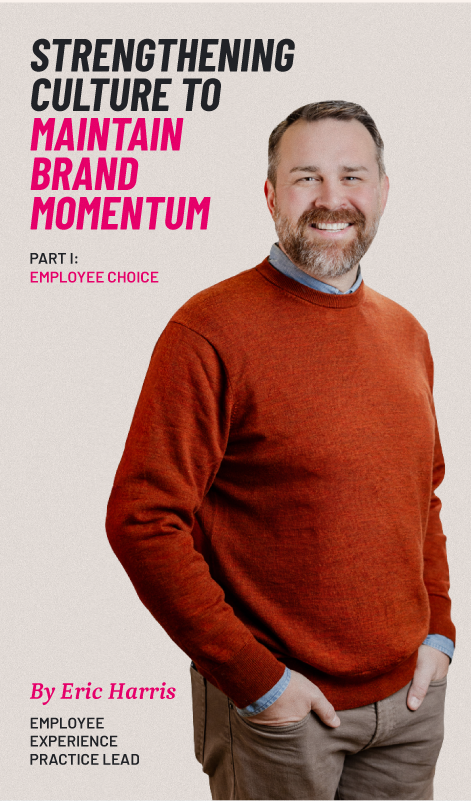Strengthening culture to maintain brand momentum – Part II: Agility

Incumbent brands must constantly innovate their organizations’ employee experience to protect from challengers looking to poach talent. What it takes to become the incumbent isn’t what it takes to remain in the lead—you have to fight to keep your brand relevant and desirable to both your customers and your people.
When reevaluating your culture (as you should regularly), I recommend investigating your organization’s agility. Agility is not merely about speed; it’s about achieving high-quality outcomes without wasting time on unnecessary judgments. By fostering agility, organizations can empower employees to act decisively and effectively, which will strengthen overall performance and brand consistency.
What is Agility?
When I think of agility, I imagine baseball players who, rather than relying solely on strength or speed, excel because they know exactly what to do when the ball comes their way. Similarly, in the workplace, the best employee experiences are designed to minimize the need for judgment calls, empowering employees with the knowledge and tools they need to act swiftly and effectively when challenges arise.

A prime example of agility (or lack thereof) in employee experience shows up in open enrollment for employee benefits. Traditionally, open enrollment has been a cumbersome process: employees are bombarded with extensive information once per year to make important choices for themselves and their families. Imagine if the organization proactively provided personalized insights: “Last year you chose these benefits. If you choose the same this year, here’s how it will impact your paycheck and your overall benefits package. Would you like to proceed with these choices, or would you prefer to make changes?” This agile approach eliminates wasted time and empowers employees to make informed decisions quickly.
Avenues to Agility
Streamlined collaboration tools
Technology plays a crucial role in facilitating collaboration among teams. However, the abundance of tools can be overwhelming. Employees often face a barrage of collaboration platforms—Slack, Teams, email, intranet—leading to frustration and inefficiency. To foster agility, organizations should streamline their collaboration tools, focusing on fewer, more effective platforms.

This includes determining and documenting the right tools and procedures for certain scenarios. As much as possible, we should eliminate time wasted by employees making a judgment on where they should post a message, who they should invite to a meeting, how they should format data, and where they can find the information to do their jobs. Once employees get this time back, they can focus on what they do best.
Data-driven decision making
In an agile culture, where quality and speed are critical, relying on data allows for quick, informed decisions to minimize the time spent deliberating. By leveraging data analytics, companies can swiftly identify trends, spot potential issues, and seize opportunities— reducing the risk of errors and enhancing the quality of decisions. With good data, published and communicated frequently, teams can act confidently and rapidly, increasing productivity while decreasing frustration.

Frost, a personal and business bank in Texas, was challenged to keep their culture intact through a period of explosive growth. To help them, we focused on how we could use data to make better decisions and reach quality candidates. We chose to measure their regrettable attrition within the first year of employment because it was the best way to find out what influenced new employees to feel like they were part of the culture, and therefore stay with the company longer. By amplifying Frost’s EVP through emotional employee testimonials, we saw a 12% decrease in this measurement of regrettable 1st-year turnover. More content led to clearer expectations for what it was like to work at Frost, which led to a decrease in turnover. The decrease led to more employee testimonials. By pinpointing which data points mattered, we directed their recruiting and retention efforts to areas that would actually tip the scales.
Data-driven Cx can also positively impact employee experiences. For example, USAA has leveraged data to improve customer service calls. When a customer calls USAA, instead of talking to a representative or a robot, their call is immediately directed to a department based on their recent USAA interactions and anticipated needs. Changes to their bill? Directed to finance. Trouble logging in? IT. The idea for the system came from customer service reps themselves and implementing it has significantly reduced inefficiencies and the need for judgment, giving employees more time for higher-value interactions.
Visible impact and progress
Most employees want to feel they are adding value, and agile processes can provide immediate feedback to them. For example, an agile remote sales team would operate under a process allowing for quick adjustments based on daily performance reviews. Each day, the team would have a brief virtual check-in to discuss the previous day’s achievements and challenges, allowing for immediate recognition of successes and swift strategy shifts if needed. When a salesperson closes a deal, it’s celebrated in the next check-in, and their techniques are quickly shared with the team to enhance overall performance. Relevant learning and development opportunities are offered based on performance and aspirations, rather than team members guessing what skills they need and where to get them.
This process of continuous feedback and rapid iteration allows employees to see the direct impact of their efforts on the team’s success and the company’s growth, fostering a strong sense of accomplishment and value. By minimizing delays and promoting real-time recognition and adaptation, agile processes help remote employees feel connected and essential to their organization’s success.
A well-oiled (human) machine
Embracing agility is essential for protecting culture and maintaining brand momentum. Agility or the perception of it can make or break an employee or candidate’s experience. By minimizing unnecessary judgments, streamlining collaboration tools, promoting continuous learning, and leveraging data-driven decision-making, organizations can empower their employees and enhance overall efficiency—resulting in a stronger and more competitive brand.
Stay tuned for Part III where I’ll dive into autonomy as another key element of internal culture.

